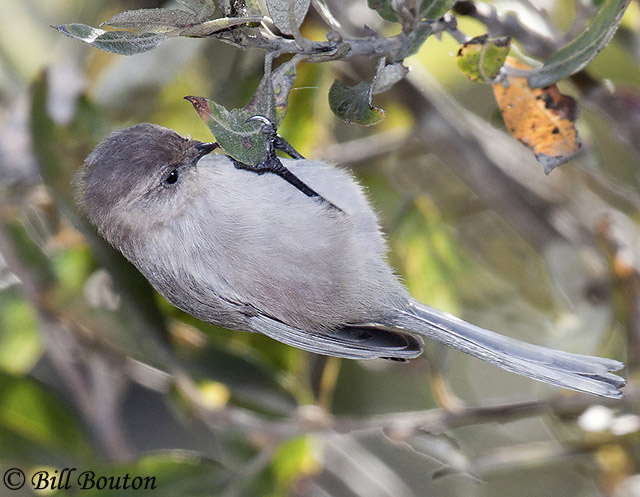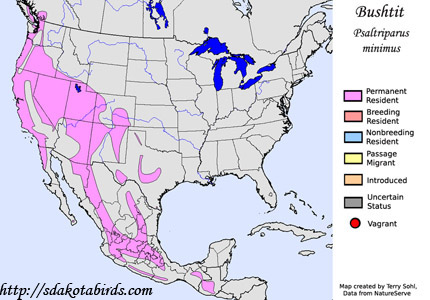Bushtit
Psaltriparus minimus
| Length: 4.5 inches | Wingspan: 6 inches | Seasonality: Non-resident in South Dakota |
| ID Keys: Tiny size, plump-looking, long tail, tiny bill, drab grayish overall | ||
 The
Bushtit is one of the smallest birds in North America, but with nests
seemingly built for a much larger bird. The drab little birds often go
unseen as they forage, but their large, bag-shaped nests of up to a foot
long are a common sight in bushes and trees in much of the western
United States. They are the only member of the Aegithalidae
family that is found in the New World, with six found in the Old World.
There are some plumage variations between birds in geographic regions, with
a "Black-eared Bushtit" race in eastern Arizona through Texas once
considered a separate species.
The
Bushtit is one of the smallest birds in North America, but with nests
seemingly built for a much larger bird. The drab little birds often go
unseen as they forage, but their large, bag-shaped nests of up to a foot
long are a common sight in bushes and trees in much of the western
United States. They are the only member of the Aegithalidae
family that is found in the New World, with six found in the Old World.
There are some plumage variations between birds in geographic regions, with
a "Black-eared Bushtit" race in eastern Arizona through Texas once
considered a separate species.
Habitat: Found in a variety of brushy or forested habitats. They aren't typically found in the high mountains or deserts of the West, but can be found in a variety of forest types, riparian areas, thickets and shrublands, woodland edges, and residential areas with thick vegetation.
Diet: Mostly feeds on insects and spiders, but will also occasionally feed on fruits, berries, and seeds.
Behavior: Gregarious outside of the breeding season, typically foraging in small flocks. They are usually very active when feeding, climbing and flitting quickly through foliage and branches of vegetation, probing for insects. They are often seen hanging upside down as they forage.
Nesting: The nest of a Bushtit is often more obvious than the birds themselves, as they build unusually large hanging bag nests for their size, with nests up to a foot long. The nests it a tightly woven mixture of grasses, lichens, moss, spider webs, and other fibrous vegetation. The female lays between 5 and 7 eggs, and both parents help to incubate the eggs. Upon hatching, the young are tended to and fed by both parents. Bushtits often will raise two broods per year.
Song: Has a variety of vocalizations comprised of high-pitched buzzing chips and chattering notes.
Migration: Considered a permanent resident throughout most of its range. However there are some elevational movements in some areas in winter, with birds moving to lower elevations, and some other birds may move relatively short distances to warmer locations for the winter.
Interactive eBird Map: Click to access an interactive eBird map of Bushtit sightings
Similar Species: Tiny size and overall structure make it relatively unique, but in range, could potentially be confused with other small, drab birds such as the Wrentit or various gnatcatcher species.
Conservation Status: Populations of Bushtit are strong and stable, and the IUCN lists them as a species of Least Concern".
Further Information: 1) BirdWeb.org - Bushtit
2) WhatBird - Bushtit
3) Audubon Guide - Bushtit
Photo Information: Photo taken by Bill Bouton - November 5th, 2011 - San Luis Obispo County, California - Licensed under Creative Commons Attribution ShareAlike 2.0 Generic License.
| Click below for a higher-resolution map |
 |
| South Dakota Status: Non-resident in South Dakota |
Additional Bushtit Photos (coming soon!!)
